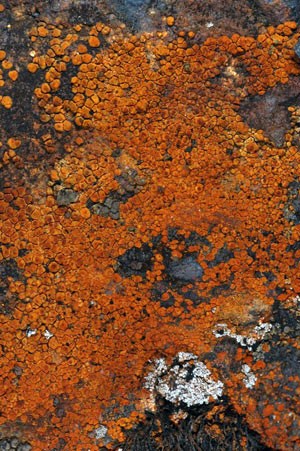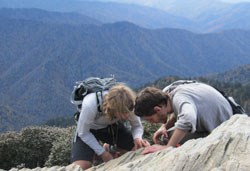
James Lendemer Photo "Other than the Smokies and a few other protected areas, lichen diversity in the East is radically different from that of a century ago," said Dr. James Lendemer of the New York Botanical Garden, as we hiked up the Noland Divide Trail out of Deep Creek. Lichens are composite organisms, usually composed of a green alga and a fungus that together can live in locations that many other forms of life cannot, such as the sun-baked exposed rock faces we were heading up the trail to find. The two parts of a lichen support each other, with the fungus providing protection for the algae and feeding off of the sugars the algae produces by photosynthesis. Lichens are named for the fungus, as often the same algal species is found in many different lichens. As we hike, we notice lichens that hang from trees like hair, bright red-tipped British soldier lichens, and leafy growths or gray "paint splotches" on tree trunks. When we get to the first rocky outcropping, Dr. Lendemer starts calling out names as if he is seeing long-lost classmates at a college reunion. A patch of yellow on a rock turns out to be Acarospora sinopica, a species that lives on exposed rocks with high iron content. It is a new park record. 
NPS photo Like me, most people focus on the larger fruticose (bush-like) and foliose (leaf-like) lichens. Dr. Lendemer and Dr. Tripp have taken on the task of bringing more attention to the lesser known world of crustose lichens. Understanding the diversity of lichens is vital to protecting them. Some species of lichens are found seemingly everywhere. Others are specialists--requiring rock with a particular chemistry or growing only on the outermost ends of dead branches. Many lichens cannot tolerate pollution, so areas with high ozone or acid deposition problems often lose most of their hair-like lichens (Usnea sp., etc.) and other sensitive species. Dr. Lendemer remarks that it is nice to walk through a forest with such high lichen diversity. Return to the Inventory and Monitoring main page. |
Last updated: November 10, 2015
